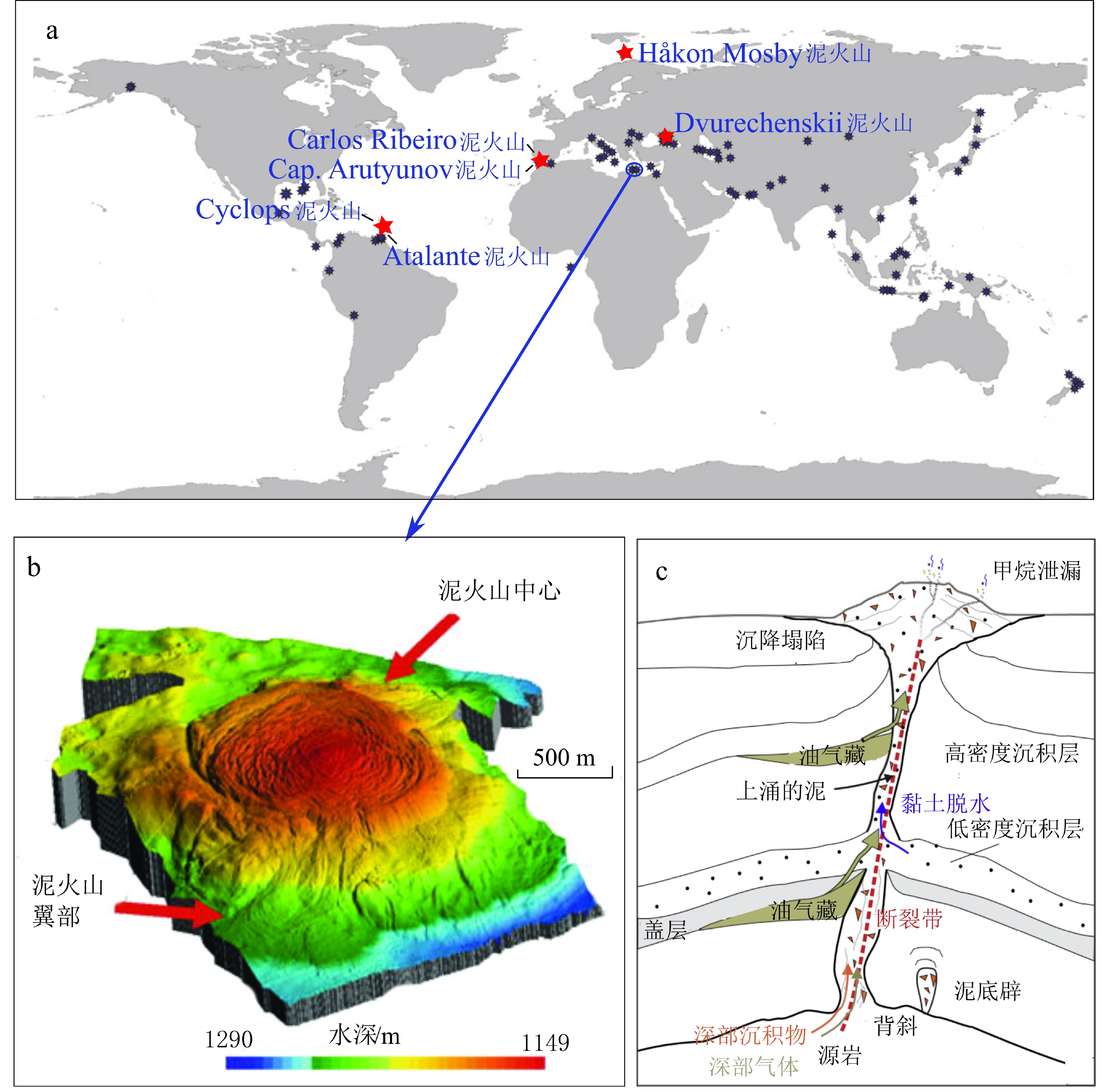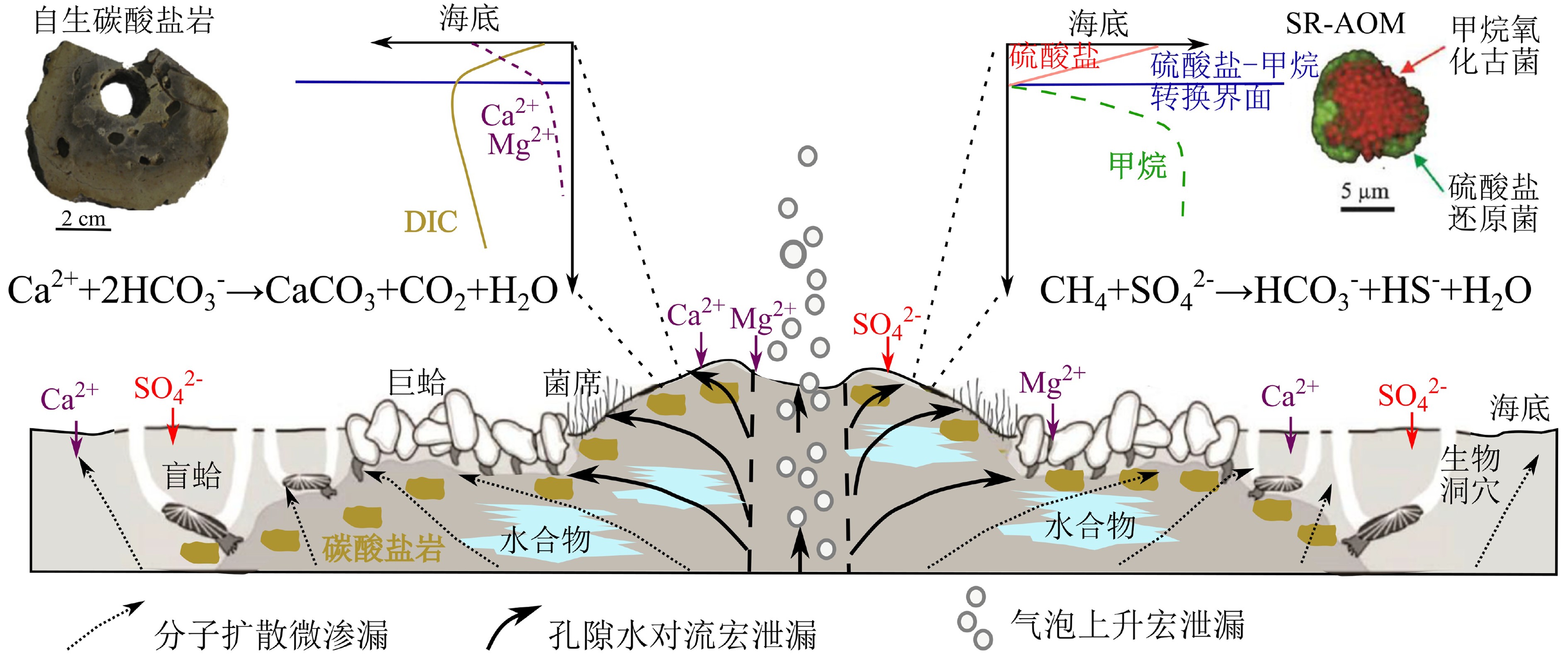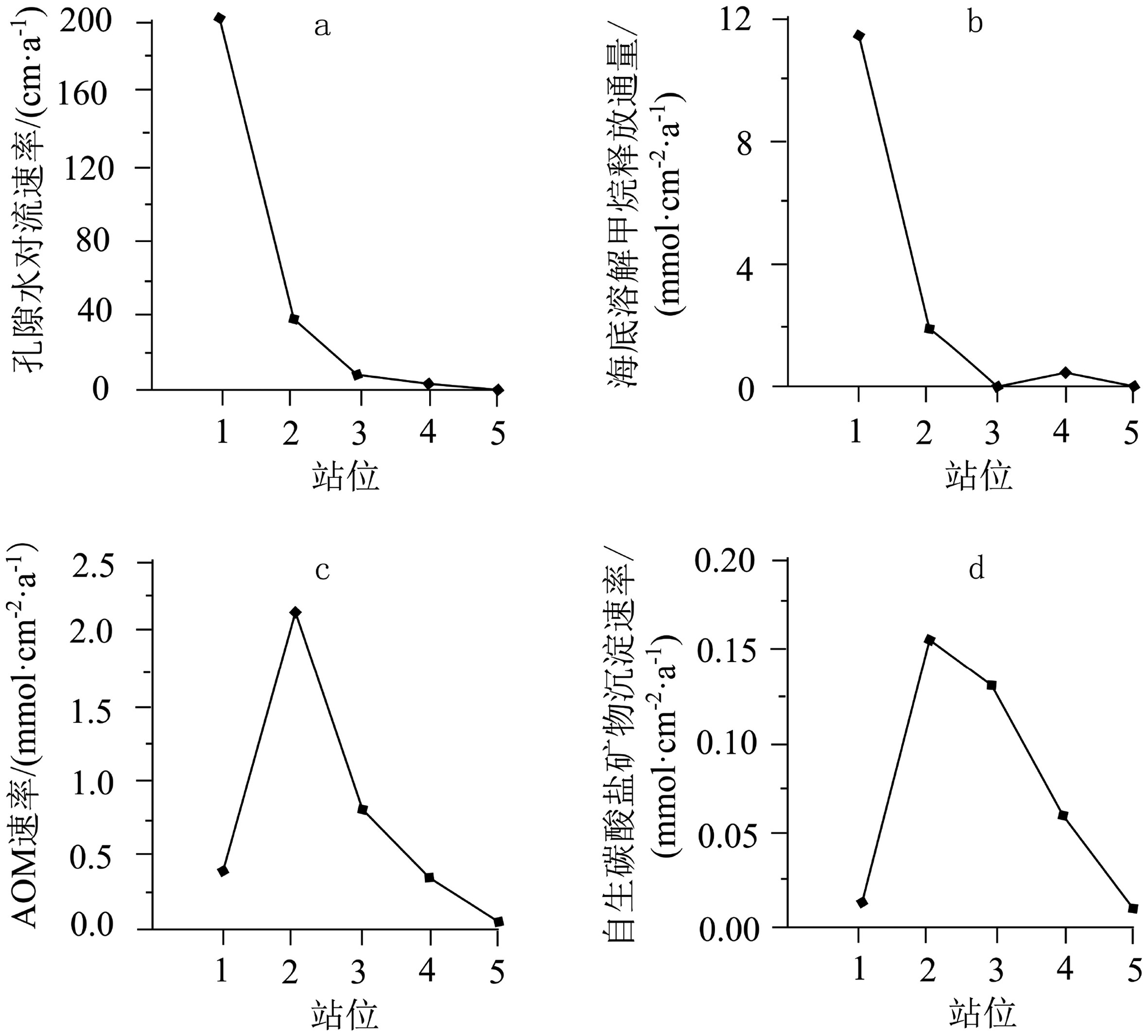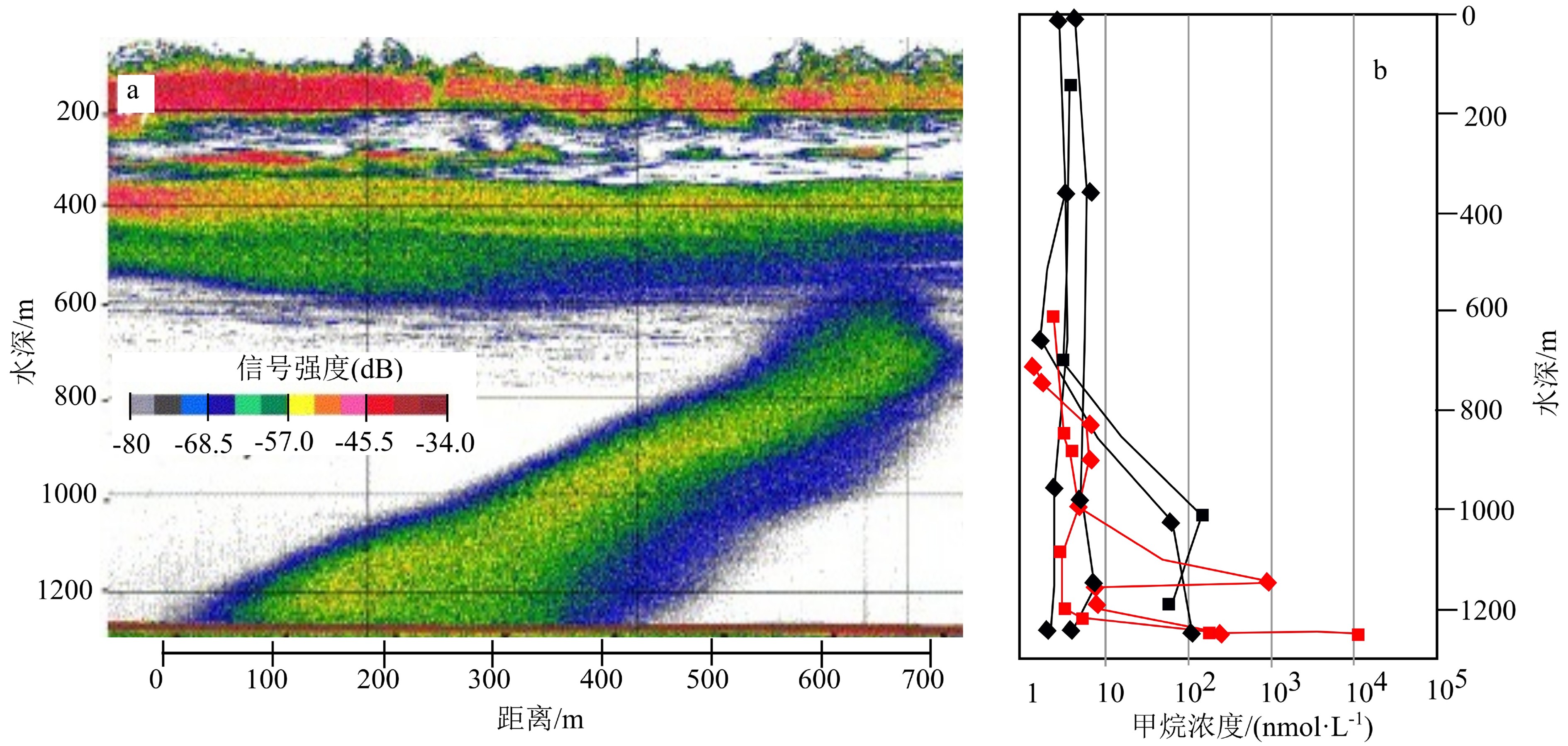Methane migration and consumption in submarine mud volcanism and their impacts on marine carbon input
-
摘要: 海底通过泥火山释放的富甲烷流体是海洋甚至大气重要的碳源之一,对该系统内甲烷迁移与转化过程开展研究,有助于精确估算其碳排放总量。系统调研了国内外文献,认识到泥火山的碳排放具有强烈的时、空变化特征。在时间上,甲烷的排放主要发生在泥火山的喷发期和平静期,而在其消亡之后只出现微量的渗漏;在空间上,一个单独的泥火山中心、翼部和外缘分别发育强甲烷气泡泄漏、中等强度富甲烷和溶解无机碳(DIC)的流体泄漏以及大面积的DIC微渗漏;甲烷厌氧氧化和碳酸盐岩沉淀作用在翼部最强,对碳排放的拦截最有效,而在中心和外缘均较慢。全球陆坡和深水盆地沉积物通过泥火山向上释放的深部来源的甲烷通量为0.02 Pg C·a−1,这些碳可能引发海水缺氧、酸化和影响海-气交换通量,从而在千年尺度甚至更短时间内影响海洋吸收大气二氧化碳的能力。将来需要进一步对海底泥火山的发育数目和喷发周期进行统计,对不同类型的泥火山开展精细调查,以准确评估沉积物中自下而上的碳排放对海洋碳循环的影响,完善全球碳循环模式。Abstract: Submarine mud volcanoes contribute carbon to the hydrosphere and the atmosphere by releasing methane-rich fluids, and researches on the temporal and spatial distribution of methane migration and chemical transportation at submarine mud volcanoes are the keys to understanding the processes mentioned above. In this paper, a large number of domestic and foreign literatures are systematically investigated, and the strong heterogeneity of methane leakage was recognized in the mud volcano systems. Methane emissions mainly occur during the eruption and dormant periods of mud volcanoes, and only a small amount of leakage occurs in extinct periods. In space, strong methane bubble leakages are usually developed around the centers of mud volcanos, and the chemical transportation efficiencies of methane are low in sediments; the leakages of methane and DIC controlled by fluid flow are mainly developed in the wings, where the rates of anaerobic oxidation of methane and the precipitation rate of authigenic carbonate are the highest. Shallow sediments have the strongest interception to carbon emission; both the intensity and the transportation rate of methane in the edge area are low, and hence a large area of DIC microleakage is developed. Globally, the carbon flux from submarine mud volcanos into shallow sediments is ca. 0.02 Pg C·a−1. The methane and DIC coming from sediments could cause seawater anoxia, acidification, and change air-sea carbon exchange fluxes, which may affect the ocean’s ability to absorb atmospheric carbon dioxide on millennium scale or even in a shorter time, and thus impacts on the global climate environment. In the future, accurate statistics on the number and eruption cycle of submarine mud volcanoes, and detailed investigations on the migration and transportation of methane in typical submarine mud volcanoes with different sizes and development stages, will be helpful to further accurately estimate their total carbon emissions, to study the impacts of bottom-up mud volcanoes’ carbon emissions on the marine carbon cycle, and to improve the marine carbon cycle model.
-
Keywords:
- submarine mud volcanoes /
- submarine methane seepage /
- AOM /
- seep carbonates /
- marine carbon cycles
-
据不完全统计,全球新发现的油气田60%来自海上,且未来油气总储量的40%将来自深水区,深水以及超深水油气勘探开发将逐渐成为油气增产和资源战略的新领域和新热点[1-4]。但如何有效规避勘探风险,提高钻井成功率,是深水油气勘探开发面临的重要挑战。对此,学者通过运用高分辨率层序地层学、三维地震属性、测井和钻井、地质露头等多种技术方法[5-15],识别深水沉积类型、分布和油气聚集关系,建立深水沉积体系下储层的识别与有利储层中油气资源的有效预测。其中,地震相-沉积相分析技术具有重要的科学指导意义。
地震相的概念是20世纪随地震地层学的兴起而逐渐推广的,其主要为沉积相在地震资料上表征的总和[16-18]。地震相分析是稀疏井网甚至无井条件下开展沉积相研究的最有效的方法。目前,国外比较流行的地震相分析主要有人工相面法、地震属性和波形分类法和基于地震切片的沉积地貌单元分析法[19-23];而国内主要采用传统地震相分析法[24-28]。
传统地震相分析在地震相-沉积相转换上存在较大误差与不确定性,例如,三角洲平原内大套洪泛平原泥岩和厚层状河道砂岩均表现出弱-空白反射;高孔渗含气砂岩和灰岩(或含灰质、钙质)均表现出强-极强振幅反射;陆架边缘三角洲和陆棚边缘进积楔都具有前积构型,但前者为低位域高含砂岩相,后者为高位域含泥岩相。针对这种情况,徐国强教授通过对南海北部珠江口盆地大量钻井的井震对比与岩性总结,提出地震反射波光滑性、地震反射整洁性和特殊波形3种新标识,来开展岩相辨别和沉积相转换,并以此推广至无井地区的地震岩相预测。
我国对北康盆地油气勘探程度较低且无钻井,国外钻井最深也仅到下中新统,对渐新统的探索几乎为零。而随着浅层可采油气资源量的不断减少,日益增长的油气需求迫使我们向深层勘探,面对成本高、风险大等问题,更加要求对实际地质情况的准确把握。本文通过开展二维地震资料综合解释,总结北康盆地晚渐新世典型地震岩相特征,并重建沉积体系。希望该研究对进一步深化北康盆地沉积认识以及为后续油气勘探工作提供基础支撑。
1. 沉积背景
北康盆地位于南海南部海域中部,南沙地块西南缘,盆地从西到东依次环绕南薇西盆地、曾母盆地、文莱-沙巴盆地、南沙海槽盆地(图1)。总面积约6×104 km2,最大沉积厚度约12000 m,水深范围100~1200 m,主体水深超过1000 m[29-37]。盆地分为3隆3坳共6个二级单元,发育齐全的新生代沉积地层,根据广州海洋地质调查局解释方案,划分出6个地质界面,T1界面为5.3 Ma,对应上新统和第四系的分界面;T2界面为10.5 Ma,对应中中新统和上中新统的分界面;T3界面为16.5 Ma,对应下中新统和中中新统的分界面;T4界面为32 Ma,对应下渐新统和上渐新统的分界面;T5界面为40.4 Ma,对应始新统和渐新统的分界面;Tg界面为58.7 Ma,是新生界的底界面(图2)。随“古南海消亡、新南海扩张”的南海构造演化史,北康盆地总体上经历了初始断陷期(湖相碎屑岩沉积)、继承性断陷期(河流、沼泽和滨浅湖相碎屑岩夹煤层沉积)、裂陷高潮期(海岸平原、浅海相沉积)和拗陷期(半深海-深海相沉积,局部发育生物礁)。其中,晚渐新世时,盆地经历裂陷高潮期,发育海岸平原富砂的砂泥互层夹煤层到浅海相砂泥互层沉积[38-44]。
2. 地震相分析
2.1 反射特征
传统地震相分析中的反射外形主要有丘状、席状、楔状以及侵蚀沟谷等。其中,丘状反射可进一步分为沉积型和非沉积型,沉积型的丘状反射外形具有明显的方向性,在横剖面上表现为丘状,在纵剖面上为楔状并呈现出向盆地方向收敛的形态;非沉积型的丘状反射不具有方向性,表现出原地生长发育的特征,例如泥底辟、火山岩体、剥蚀残丘等。席状反射表现为顶底面呈平行或亚平行的层状沉积体,分布范围广,沉积厚度大,发育于中陆棚、外陆棚、宽缓的陆坡和深海平原等非常开阔平坦的古地理环境。楔状反射主要有单边断陷同沉积楔状体和陆架边缘前积楔两大类,前者发育于盆地内大型断裂一侧,靠近断裂的凹陷可堆积巨厚的沉积物,翘倾隆起端则相对较薄;而陆架边缘三角洲、富泥型陆棚边缘前积楔和礁前斜坡都会发育向盆地方向收敛的陆架边缘前积楔。侵蚀沟谷主要为河流途经后的产物,根据水流的势能而呈现不同的深度和宽度。
2.2 内部反射结构
内部反射结构受控于反射外形,两者间一般具有匹配关系,常见的有平行、亚平行、斜交型(S型斜交、平行斜交、叠瓦状斜交等)、收敛或发散型以及充填结构等。平行或亚平行主要见于席状反射体内,指示细粒沉积物,例如纯泥岩层、薄层粉砂岩等。斜交型与丘状反射体或滩状反射有关,例如随三角洲的前积而向盆地方向迁移的S型斜交、或河控三角洲的平行斜交、或浪控三角洲的叠瓦状斜交。收敛或发散型与楔状反射体有关,呈凹陷处发散而隆起端收敛的特征。充填结构发育于侵蚀沟谷内,可表现为槽状交错结构、上超充填、侧向加积和杂乱空白。
2.3 振幅、频率、连续性
地震反射波的振幅主要反映上下岩层界面的波阻抗差异大小,它与岩性、孔隙度、充填介质及厚度多种因素有关。可分为弱振幅、中振幅、强振幅和极强振幅,若上下岩层间的波阻抗差异较小或在大套同时期沉积体内部(无波阻抗差异),则表现出弱振幅反射;若上下岩层间波阻抗差异较大,如煤层、欠压实泥岩、含气砂岩与泥灰岩、灰岩和玄武岩,则表现出强—极强振幅反射。
频率指单位时间内反射波的数量,主要指示岩性在纵向上变化的频繁程度。一般地,高频代表纵向上岩性变化非常频繁,如砂泥岩薄互层;低频代表纵向上岩性变化不频繁,单位时间内反射界面少。
地震反射同相轴的连续性反映的是地层横向分布的稳定性,一般地,河流相砂体的横向分布不稳定,通常产生短轴不连续反射;经过波浪和潮汐摊平的河口坝、席状砂、沿岸砂坝和远砂坝砂体,分布范围相对较宽,产生连续反射。
2.4 地震同相轴光滑性
地震同相轴光滑性指沉积层表面的平整程度,当地层横向沉积稳定、分布广泛时,通常表现出连续性的特征。例如,发育于陆架边缘的三角洲前缘席状砂由于受海浪冲刷作用,分布广且平整性好而产生连续反射;海进期沉积的灰岩层或含灰质(钙质)层表面平整且横向分布非常稳定亦表现出连续反射,并且当砂岩含气或孔渗性极好时,呈强—极强振幅反射,与灰岩层或含灰质(钙质)层振幅相似,这给研究判断带来迷惑性。因此,在连续性的基础上,增加光滑性用以表征沉积层表面的平整程度,突出其主要受沉积物组分的性质和成因影响。灰岩层或含灰质(钙质)层主要通过物质的化学沉淀和结晶形成,同相轴表面呈极光滑的特征;而三角洲前缘席状砂由河流搬运的物理沉积形成,尽管受波浪、潮汐等水动力作用,但同相轴表面呈凹凸起伏,光滑性较差(图3)。
2.5 特殊波形
Anstey[45]通过利用不同地震子波形态来直接识别砂岩储集层的相关问题。之后,通过利用大量详实的钻井资料,并结合切实的地质模型研究发现,在特定的沉积环境下,利用地震波形分析方法是可行、可信的,并总结出零十字对称、斜十字对称和低频不对称波形为三种基本地震反射波型。
下文主要指低速和高速夹层所表现出的斜十字对称波形。例如,高孔渗砂岩由于波阻抗低于上下围岩,其顶面为负反射,对应波谷;底面为正反射,对应波峰,整体呈现一个右下倾斜对称的形态,即A1与A4、A2与A3均呈斜十字对称,从A2到A3振幅变化最大(图4),若砂岩含气时,A2到A3将表现出更大的振幅。灰岩、火山熔岩或钙质砂岩,其波阻抗远大于上下围岩,顶面为正反射,对应于波峰;底面为负反射,对应于波谷,整体表现出一个左下倾斜对称波形(图4)。结合地震相分析,高孔渗砂岩主要有河流相砂、河口坝砂、三角洲前缘席状砂等;灰岩发育于海进期没有陆缘碎屑供应的陆架、台地等浅海环境;火山熔岩在火山口附近,发育于任何水深。
2.6 地震反射剖面整洁性
地震反射剖面整洁性指沉积层内部结构的变化,沉积地层内部结构、岩性变化以及外来物数量等,均会引起宏观层界面同相轴振幅的变化,这种变化在纵横向上延伸至更大范围时,就可以在剖面上辨别出来,表现出不干净和干净的画面。例如内部结构的变化,河流相砂岩因其内部地层结构横向不稳定或产生突变(如槽状交错充填)而表现出不干净画面;三角洲前缘席状砂、河口坝砂等因其内部地层结构横向上稳定(平行层状加积)而呈干净反射。又如岩性变化,大套河流相砂岩和静水泥岩尽管均表现为弱振幅反射,但砂岩内部稳定性差、岩性变化快,表现出不干净画面;而泥岩内部物质均一、地层平整且横向稳定,整个反射画面看起来显得整洁干净。最后,当层状介质中夹杂其他外来沉积物时,将会导致同相轴波形的突变,在变密度剖面中表现出不同程度的“变脏”,如砂泥岩地层中夹杂火山碎屑、静水泥岩中夹杂浊积岩、灰岩或煤层中夹杂砂岩等(图5)。
3. 北康盆地主要地震岩相特征
3.1 国外钻井分析
通过收集周边国家在北康盆地和曾母盆地的钻井信息,将岩性信息植入地震剖面,利用传统地震相分析和3种新增标识,开展钻井岩性与井旁地震反射特征研究(图6),总结出主要的地震岩相有:
①砂砾岩相:砂砾岩混杂,由于砂砾岩间波阻抗差异较大而表现出中—强振幅反射;主要发育在冲积平原—河流的高能环境中,且快速堆积而成,沉积物在纵向上厚度大,横向上稳定性差而表现出中—低频、杂乱不光滑以及不干净反射。
②砂包泥相:泥岩以条带状的形式嵌于砂岩中,砂岩层之间由于波阻抗差异较小,总体呈弱反射的地震响应;主要发育在河流—三角洲平原的高能环境中,砂体沉积厚度大且内部存在的各种层理面(弱波阻抗差异界面)横向稳定性差,表现出中—低频、短轴不光滑及不干净反射。
③砂泥岩互层相:砂泥岩以层状形式相互叠置,砂泥岩之间由于波阻抗差异大而表现出中—强振幅反射;常见于三角洲前缘环境或高含砂的滨岸砂坝环境,砂岩和泥岩都比较纯且横向连续性较好而表现出中—高频、光滑连续反射。
④灰岩(或含钙质、灰质)相:由于与围岩巨大的波阻抗差异而表现出强振幅反射;而灰岩层表面的平整性以及灰岩分布的广泛性使其呈现出极光滑连续性;低—中频主要为强振幅造成的假象。
⑤泥包砂相:砂岩被周围大套泥岩包裹,砂体以短轴不连续反射或孤立状反射,置于弱振幅泥岩背景中而呈中—强振幅、中—低频、不光滑反射;通常为发育在陆坡或盆底的深水扇砂体。
⑥纯泥(页)岩相:发育于静水环境而呈水平层状;较低的沉积速率表现出中—高频;横向上地层结构、岩石类型大致相同或相似,纵向上层与层之间波阻抗差异甚小,总体表现为光滑连续干净反射。
⑦泥夹粉砂(细沙)相:主要发育于前三角洲或深海平原等低能环境,粉砂岩(细砂岩)和泥岩呈平铺式展布沉积而表现出光滑连续的水平层状反射;由于粉砂岩(细砂岩)与泥岩之间波阻抗差异较小且沉积速率低而表现为弱—中振幅、中—高频、较干净反射。
3.2 北康盆地主要地震岩相
基于上述钻井分析,结合传统地震相和3种新增标识建立北康盆地综合地震相分析方法(图7),通过开展北康盆地地震资料连片解释,识别出北康盆地8种主要地震岩相,即砂砾岩相、砂包泥相、砂泥岩互层相、泥包砂相、纯泥(页)岩相、泥夹粉砂(细沙)相、灰岩(含钙质)相和火山岩相(图8)。其中火山岩相尽管在所收集的钻井中未钻遇,通过已有研究成果判别北康盆地主要包括火山熔岩、火山碎屑岩和火山侵入岩。其中,火山熔岩呈连续极强振幅反射,地震波形表现为高速层的左下倾斜对称波形;火山口附近的火山碎屑岩或撒落后的火山碎屑表现出中—强振幅、没有生根、内部呈杂乱或空白反射的特征,翼部为没有构造形态丘状反射体;而火山侵入岩则有“根”且翼部发生构造形变。
4. 北康盆地晚渐新世沉积体系构建
4.1 方法和原理
通过地震相定性标定,将不同的地震相标定解释结果叠合到同一张平面图上,生成地震相线图,再利用地震相-地震岩相的方法,将地震相线图转换为岩相图。这里的岩相分析为主要的骨架岩相分布图,即碎屑岩岩相主要包括砂砾岩、砂包泥岩、砂泥岩互层和泥包砂岩;灰岩和火山岩为特殊岩性;纯泥岩和泥夹粉砂岩为充填岩性。
在骨架岩相分布图的基础上,结合北康盆地上渐新统等厚度图,通过海岸线(陆相沉积地层不连续反射与海相沉积地层连续反射的分界带)、陆架坡折带(沉积地层产状和堆积方式由水平层状加积堆积转变为“S”型斜交前积堆积的突变处)和深水盆地(弱振幅、中—高频、连续层状反射)等来圈定内陆架(滨浅海)、陆架边缘—斜坡、深海盆地的大类环境相图。
陆源碎屑沉积物主要通过大型河流带来,通过识别地震剖面上的侵蚀沟谷或根据等厚度图上高地势夹低谷来确定主要的水流路径,得到水流路径图。最后将岩相图、环境相图和水流路径图叠合在一起,得到较准确的沉积体系图。
4.2 北康盆地晚渐新世沉积体系特征
北康盆地上渐新统内主要发育6类典型地震相(图9),即:① 中—强振幅、中—低频,杂乱不连续、不干净反射;② 弱振幅、中—低频,短轴不连续、不干净反射;③ 中—强振幅、中—高频,光滑连续、较干净反射;④ 弱振幅干净反射背景中,中—强振幅、短轴不连续反射;⑤ 弱振幅、中—高频,光滑连续、干净反射;⑥ 中—强振幅、内部杂乱或近空白反射,具有侧积或刺穿特征。将该6类地震相进行转换,得到北康盆地上渐新统6类主要岩相,即砂砾岩相、砂包泥岩相、砂泥岩互层相、泥包砂岩相、火山岩相和纯泥岩相(图10)。其中曾母盆地的康西坳陷、北康盆地的南部坳陷以及中部坳陷的西南部为砂岩发育的有利相带;北康盆地中部坳陷和北部坳陷发育深水浊积砂岩;火山岩主要分布于两盆地交界处以及北康盆地深水区;在三角洲相间处发育静水泥岩。
晚渐新世时为南海同扩张期,盆地强烈伸展,南部的曾母盆地开始进入周缘前陆阶段,而北康盆地主要以滨浅海相沉积为主,局部可见半深海相沉积。从南至北依次为三角洲、浅海、半深海-深海的沉积环境。
研究分析表明,沉积物源主要来自南部陆地,尤其是婆罗洲山地,受沙巴造山运动的影响,通过拉让江和巴兰河分别从南面和东南面向盆地凹陷内搬运沉积物,主水流距离超过40 km,进入陆架后分叉为多支较小水流,形成多个三角洲-深水扇沉积体系。此外,还有来自西北方向(印支半岛)的物源进入研究区,其规模较小[46-47]。
综上,北康盆地晚渐新世主要发育河流三角洲、陆架浅海、陆坡浊积扇和深海盆地4种沉积体系(图11)。在盆地南部和东南部的陆架-斜坡区域发育大型三角洲-深水扇沉积体系,其沉积物源主要来自南部婆罗洲地区,其中发育于曾母盆地康西坳陷和北康盆地南部坳陷的三角洲和斜坡扇砂体有形成优质储层的潜力。
5. 结论
(1)光滑性主要表征沉积地层界面的平整程度,突出其主要受沉积物组分的性质和成因影响;特殊波形中的斜对称波形可有效识别低速和高速夹层;画面整洁性是内部岩石物理特性的表现,沉积物质均一、沉积环境稳定且无外来物质,将呈干净整洁的画面。利用该3种新标识,建立地震岩相的分析方法,在开展无井地区的沉积相转换上精度大幅提升且信息更加准确。
(2)北康盆地晚渐新世主要发育6种地震岩相,即砂砾岩相、砂包泥相、砂泥岩互层相、泥包砂相、纯泥(页)岩相和火山岩相;主要沉积物源为来自南部婆罗洲,通过拉让江和巴兰河运送至盆地沉积。
(3)北康盆地晚渐新世主要发育河流三角洲、陆架浅海、陆坡浊积扇和深海盆地4种沉积体系,形成了陆架三角洲-陆坡浊积体-深海盆地沉积体系以及火成岩体的空间展布体系。
(4)基于地震岩相分析,结合沉积环境获得较为准确的北康盆地晚渐新世沉积体系图,为北康盆地油气勘探提供有效的地质基础支持。
-
图 1 海底泥火山的分布、地貌和构造图
a. 全球已发现的陆地和海底泥火山分布图[17]及表2中的海底泥火山 (红色星型),b. 尼罗河深海扇海底泥火山地形图[14],c. 海底泥火山构造模型图[17]。
Figure 1. The distribution、topography and structure of submarine mud volcanoes
a. distribution of terrestrial and submarine mud volcanoes in the world[17], and submarine mud volcanoes (red star) in Table 2; b. bathymetric map of submarine mud volcano in the Nile deep sea fan[14]; c. Sketch map of mud volcano structure[17].
图 3 哥斯达黎加岸外冷泉区5个沉积柱站位的甲烷释放速率和转化速率[45]
a. 孔隙水对流速率,b. 沉积物―水界面甲烷泄漏通量,c. AOM速率,d. 碳酸盐岩沉淀速率图。
Figure 3. The methane migration and consumption rates at five gravity core sites in cold seep area offshore Costa Rica[45]
a. pore water advection rates, b. methane fluxes at sediment-water interface, c. AOM rates, d. carbonate precipitation rates.
图 4 海洋碳循环及海底冷泉活动对海洋碳循环的影响示意图
方括号内的数字表示碳库量,单位为Pg C,箭头旁边不带括号的数字表示年度通量,单位为Pg C·a−1。参考文献a-[67-68]; b-[64]; c-[60]; d-[22]; e-[69]。
Figure 4. schematic diagram of marine carbon cycle and the impact of sedimentary methane emissions on marine carbon cycle
the number in square brackets represents the carbon pool in Pg C, and the number without brackets next to the arrow represents annual flux in Pg C·a−1. References a-[67-68]; b-[64]; c-[60]; d-[22]; e-[69].
表 1 巴伦支海Håkon Mosby泥火山中心到边缘不同生态分区的甲烷泄漏强度[15, 30-31]
Table 1 intensities of methane emission from the center to the edge of the Håkon Mosby Mud Volcanoin the Barents Sea[15, 30-31]
生态分区 面积/
m2对流速率/
(cm·a−1)深部甲烷泄漏 AOM 海底甲烷通量/
(106 mol·a−1)通量/
(mol·m-2·a−1)流量/
(106 mol·a−1)速率/
(mol·m−2·a−1)总速率/
(106 mol·a−1)效率/
%泥火山中心 300~600 高热流区 14 >182.5 2.6 1.8 0.04 1 2.6 次高热流区 101 22.3~28.5 2.6 1.1 0.1 4 2.4 气泡羽流 8~35 0 0 8~35 Beggiatoa 密集菌席 30 60~100 32.1 0.9 3.6 0.1 12 0.8 斑状菌席 55 0.6 0.07 12 0.5 灰色菌席 菌席 80 13.1 1 3.9 0.3 32 0.7 菌席附近 60 >102.2 6.2 6.2 管状虫 Siboglinid 410 40 8.4 3.3 7.6 3.1 93 0.2 合计 750 17.3aq+(8~35)g 3.8 22 13.5aq+(8~35)g 注:下标aq表示溶解态,g表示气态 表 2 不同海域海底泥火山的溶解态甲烷泄漏强度统计
Table 2 Statistics of the intensities of dissolved methane seepage from mud volcanoes in different sea areas
泥火山 面积/km2 流体对流速率/
(cm·a−1)深部来源甲烷流量/
(106 mol·a−1)AOM速率/
(106 mol·a−1)AOM效率/% 海底甲烷流量/
(106 mol·a−1)参考文献 黑海 Dvurechenskii泥火山 3 8~25 8.9 7 73~84 1.9 [11] Dvurechenskii泥火山 30~150 19~27 14 50~70 13 [33] 巴伦支海 Håkon Mosby泥火山 0.75 40~530 17.3 3.8 22 13.5 [15, 31] 巴巴多斯岸外 Atalante泥火山 10~150 6.5 [11] Cyclops泥火山 7~50 0.6 哥斯达黎加岸外 Mound 12 5 10 0.4 [34] Mound 11 - 5 0.07 Mound Culebra 5 - 0.6 格雷仕湾 Carlos Ribeiro 1.77 0.4~4 0.1 0.085 85 0.015 [35] Cap. Arutyunov 3.14 10~15 0.006 [36] Ginsburg泥火山 3 [16] Bonjardim泥火山 0.8 1.3 -
[1] Kopf A J. Significance of mud volcanism [J]. Reviews of Geophysics, 2002, 40(2): 2-1-2-52.
[2] Dimitrov L I. Mud volcanoes—the most important pathway for degassing deeply buried sediments [J]. Earth Science Reviews, 2002, 59(1-4): 49-76. doi: 10.1016/S0012-8252(02)00069-7
[3] Zheng G D, Ma X X, Guo Z F, et al. Gas geochemistry and methane emission from Dushanzi mud volcanoes in the southern Junggar Basin, NW China [J]. Journal of Asian Earth Sciences, 2017, 149: 184-190. doi: 10.1016/j.jseaes.2017.08.023
[4] Etiope G, Milkov A V. A new estimate of global methane flux from onshore and shallow submarine mud volcanoes to the atmosphere [J]. Environmental Geology, 2004, 46(8): 997-1002. doi: 10.1007/s00254-004-1085-1
[5] 马向贤, 郑国东, 郭正府, 等. 准噶尔盆地南缘独山子泥火山温室气体排放通量[J]. 科学通报, 2014, 59(32):3190-3196. [MA Xiangxian, ZHENG Guodong, GUO Zhengfu, et al. Estimation of greenhouse gas flux from mud volcanoes in the Dushanzi area, southern Junggar Basin of Northwest China [J]. Chinese Science Bulletin, 2014, 59(32): 3190-3196. doi: 10.1360/N972014-00361 [6] 陈多福, 李绪宣, 夏斌. 南海琼东南盆地天然气水合物稳定域分布特征及资源预测[J]. 地球物理学报, 2004, 47(3):483-489. [CHEN Duofu, LI Xuxuan, XIA Bin. Distribution of gas hydrate stable zones and resource prediction in the Qiongdongnan basin of the South China Sea [J]. Chinese Journal of Geophysics, 2004, 47(3): 483-489. doi: 10.3321/j.issn:0001-5733.2004.03.018 [7] 何家雄, 祝有海, 翁荣南, 等. 南海北部边缘盆地泥底辟及泥火山特征及其与油气运聚关系[J]. 地球科学, 2010, 35(1):75-86. [HE Jiaxiong, ZHU Youhai, WENG Rongnan, et al. Characters of North-West Mud Diapirs volcanoes in South China Sea and relationship between them and accumulation and migration of oil and gas [J]. Earth Science, 2010, 35(1): 75-86. [8] 阎贫, 王彦林, 郑红波, 等. 东沙群岛西南海区泥火山的地球物理特征[J]. 海洋学报, 2014, 36(7):142-148. [YAN Pin, WANG Yanlin, ZHENG Hongbo, et al. Geophysical features of mud volcanoes in the waters southwest of the Dongsha islands [J]. Acta Oceanologica Sinica, 2014, 36(7): 142-148. [9] Xu C L, Sun Z L, Geng W, et al. Thermal recovery method of submarine gas hydrate based on a thermoelectric generator [J]. China Geology, 2018, 1(4): 568-569. doi: 10.31035/cg2018068
[10] Sun Z L, Cao H, Geng W, et al. A three-dimensional environmental monitoring system for the production of marine gas hydrates [J]. China Geology, 2018, 1(4): 570-571. doi: 10.31035/cg2018066
[11] Wallmann K, Drews M, Aloisi G, et al. Methane discharge into the Black Sea and the global ocean via fluid flow through submarine mud volcanoes [J]. Earth & Planetary Science Letters, 2006, 248(1-2): 545-560.
[12] Niemann H, Duarte J, Hensen C, et al. Microbial methane turnover at mud volcanoes of the Gulf of Cadiz [J]. Geochimica Et Cosmochimica Acta, 2006, 70(21): 5336-5355. doi: 10.1016/j.gca.2006.08.010
[13] Wan Z F, Yao Y J, Chen K W, et al. Characterization of mud volcanoes in the northern Zhongjiannan Basin, western South China Sea [J]. Geological Journal, 2019, 54(1): 177-189. doi: 10.1002/gj.3168
[14] Dupré S, Buffet G, Mascle J, et al. High-resolution mapping of large gas emitting mud volcanoes on the Egyptian continental margin (Nile Deep Sea Fan) by AUV surveys [J]. Marine Geophysical Research, 2008, 29(4): 275-290. doi: 10.1007/s11001-009-9063-3
[15] de Beer D, Sauter E, Niemann H, et al. In situ fluxes and zonation of microbial activity in surface sediments of the Håkon Mosby Mud Volcano [J]. Limnology & Oceanography, 2006, 51(3): 1315-1331.
[16] Hensen C, Nuzzo M, Hornibrook E, et al. Sources of mud volcano fluids in the Gulf of Cadiz—indications for hydrothermal imprint [J]. Geochimica et Cosmochimica Acta, 2007, 71(5): 1232-1248. doi: 10.1016/j.gca.2006.11.022
[17] Mazzini A, Etiope G. Mud volcanism: An updated review [J]. Earth-Science Reviews, 2017, 168: 81-112. doi: 10.1016/j.earscirev.2017.03.001
[18] ZHANG J, LEI H Y, CHEN Y, et al. Carbon and oxygen isotope composition of carbonate in bulk sediment in the southwest Taiwan Basin, South China Sea: methane hydrate decomposition history and its link to mud volcano eruption [J]. Marine & Petroleum Geology, 2018, 98: 687-696.
[19] Yan P, Wang Y L, Liu J, et al. Discovery of the southwest Dongsha Island mud volcanoes amid the northern margin of the South China Sea [J]. Marine & Petroleum Geology, 2017, 88: 858-870.
[20] Chen J X, Song H B, Guan Y X, et al. Morphologies, classification and genesis of pockmarks, mud volcanoes and associated fluid escape features in the northern Zhongjiannan Basin, South China Sea [J]. Deep Sea Research Part II: Topical Studies in Oceanography, 2015, 122: 106-117. doi: 10.1016/j.dsr2.2015.11.007
[21] Ciais P, Sabine C, Bala G, et al. Carbon and other biogeochemical cycles[M]//Climate Change 2013: The Physical Science Basis. Contribution of Working Group I to the Fifth Assessment Report of the Intergovernmental Panel on Climate Change. Cambridge: Cambridge University Press, 2014: 465-570.
[22] Reeburgh W S. Oceanic methane biogeochemistry [J]. Chemical Reviews, 2007, 107(2): 486-513. doi: 10.1021/cr050362v
[23] 冯东, 陈多福, 苏正, 等. 海底天然气渗漏系统微生物作用及冷泉碳酸盐岩的特征[J]. 现代地质, 2005, 19(1):26-32. [FEND Dong, CHEN Duofu, SU Zheng, et al. Characteristics of cold seep carbonates and microbial processes in gas seep system [J]. Geoscience, 2005, 19(1): 26-32. doi: 10.3969/j.issn.1000-8527.2005.01.004 [24] Xu C L, Wu N Y, Sun Z L, et al. Methane seepage inferred from pore water geochemistry in shallow sediments in the western slope of the Mid-Okinawa Trough [J]. Marine and Petroleum Geology, 2018, 98: 306-315. doi: 10.1016/j.marpetgeo.2018.08.021
[25] Caprais J C, Lanteri N, Crassous P, et al. A new CALMAR benthic chamber operating by submersible: First application in the cold-seep environment of Napoli mud volcano (Mediterranean Sea) [J]. Limnology & Oceanography Methods, 2010, 8(6): 304-312.
[26] Sun M S, Zhang G L, Ma X, et al. Dissolved methane in the East China Sea: Distribution, seasonal variation and emission [J]. Marine Chemistry, 2018, 202: 12-26. doi: 10.1016/j.marchem.2018.03.001
[27] 孙治雷, 魏合龙, 王利波, 等. 海底冷泉系统的碳循环问题及探测[J]. 应用海洋学报, 2016, 35(3):442-450. [SUN Zhilei, WEI Helong, WANG Libo, et al. Focus issues of carbon cycle and detecting technologies in seafloor cold seepages [J]. Journal of Applied Oceanography, 2016, 35(3): 442-450. [28] Judd A, Hovland M. Seabed Fluid Flow—the Impact on Geology, Biology and the Marine Environment[M]. Cambridge: Cambridge University Press, 2007:195-205.
[29] Milkov A V, Vogt P R, Crane K, et al. Geological, geochemical, and microbial processes at the hydrate-bearing Hakon Mosby mud volcano: a review [J]. Chemical Geology, 2004, 205(3-4): 347-366. doi: 10.1016/j.chemgeo.2003.12.030
[30] Sauter E J, Muyakshin S I, Charlou J L, et al. Methane discharge from a deep-sea submarine mud volcano into the upper water column by gas hydrate-coated methane bubbles [J]. Earth & Planetary Science Letters, 2006, 243(3-4): 354-365.
[31] Felden J, Wenzhöfer F, Feseker T, et al. Transport and consumption of oxygen and methane in different habitats of the Håkon Mosby Mud Volcano (HMMV) [J]. Limnology & Oceanography, 2010, 55(6): 2366-2380.
[32] Bohrmann G, Torres M E. Gas hydrates in marine sediments[M]//Schulz H, Zabel M. Marine Geochemistry. Berlin, Heidelberg: Springer-Verlag, 2006: 481-512.
[33] Lichtschlag A, Felden J, Wenzhöfer F, et al. Methane and sulfide fluxes in permanent anoxia: in situ studies at the Dvurechenskii mud volcano (Sorokin Trough, Black Sea) [J]. Geochimica et Cosmochimica Acta, 2010, 74(17): 5002-5018. doi: 10.1016/j.gca.2010.05.031
[34] Linke P, Wallmann K, Suess E, et al. In situ benthic fluxes from an intermittently active mud volcano at the Costa Rica convergent margin [J]. Earth & Planetary Science Letters, 2005, 235(1-2): 79-95.
[35] Vanneste H, Kelly-Gerreyn B A, Connelly D P, et al. Spatial variation in fluid flow and geochemical fluxes across the sediment–seawater interface at the Carlos Ribeiro mud volcano (Gulf of Cadiz) [J]. Geochimica Et Cosmochimica Acta, 2011, 75(4): 1124-1144. doi: 10.1016/j.gca.2010.11.017
[36] Sommer S, Linke P, Pfannkuche O, et al. Seabed methane emissions and the habitat of frenulate tubeworms on the Captain Arutyunov mud volcano (Gulf of Cadiz) [J]. Marine Ecology Progress Series, 2009, 382: 69-86. doi: 10.3354/meps07956
[37] Praeg D, Ceramicola S, Barbieri R, et al. Tectonically-driven mud volcanism since the late Pliocene on the Calabrian accretionary prism, central Mediterranean Sea [J]. Marine & Petroleum Geology, 2009, 26(9): 1849-1865.
[38] Toyos M H, Medialdea T, León R, et al. Evidence of episodic long-lived eruptions in the Yuma, Ginsburg, Jesús Baraza and Tasyo mud volcanoes, Gulf of Cádiz [J]. Geo Marine Letters, 2016, 36(3): 197-214. doi: 10.1007/s00367-016-0440-z
[39] 黄华谷, 邸鹏飞, 陈多福. 泥火山的全球分布和研究进展[J]. 矿物岩石地球化学通报, 2011, 30(2):189-197. [HUANG Huagu, DI Pengfei, CHEN Duofu. Global distribution and research progress of mud volcanoes [J]. Bulletin of Mineralogy, Petrology and Geochemistry, 2011, 30(2): 189-197. doi: 10.3969/j.issn.1007-2802.2011.02.010 [40] Deville E, Guerlais S H. Cyclic activity of mud volcanoes: Evidences from Trinidad (SE Caribbean) [J]. Marine & Petroleum Geology, 2009, 26(9): 1681-1691.
[41] 王家生, Suess E. 天然气水合物伴生的沉积物碳、氧稳定同位素示踪[J]. 科学通报, 2002, 47(15):1172-1176. [WANG Jiasheng, Suess E. Carbon and oxygen stable isotope tracing of sediments associated with gas hydrate [J]. Chinese Science Bulletin, 2002, 47(15): 1172-1176. doi: 10.3321/j.issn:0023-074X.2002.15.012 [42] Sun Z L, Wei H L, Zhang X H, et al. A unique Fe-rich carbonate chimney associated with cold seeps in the Northern Okinawa Trough, East China Sea [J]. Deep Sea Research Part I: Oceanographic Research Papers, 2015, 95: 37-53. doi: 10.1016/j.dsr.2014.10.005
[43] Luo M, Torres M E, Hong W L, et al. Impact of iron release by volcanic ash alteration on carbon cycling in sediments of the northern Hikurangi margin [J]. Earth and Planetary Science Letters, 2020, 541: 116288. doi: 10.1016/j.jpgl.2020.116288
[44] Egger M, Hagens M, Sapart C J, et al. Iron oxide reduction in methane-rich deep Baltic Sea sediment [J]. Geochimica et Cosmochimica Acta, 2017, 207: 256-276. doi: 10.1016/j.gca.2017.03.019
[45] Karaca D, Hensen C, Wallmann K. Controls on authigenic carbonate precipitation at cold seeps along the convergent margin off Costa Rica [J]. Geochemistry, Geophysics, Geosystems, 2010, 11(8): Q08S27.
[46] Lein A Y, Pimenov N V, Savviechev A S, et al. Methane as a source of organic matter and carbon dioxide of carbonates at a cold seep in the Norway Sea [J]. Geochemistry International, 2000, 38(3): 232-245.
[47] Niemann H, Linke P, Knittel K, et al. Methane-carbon flow into the benthic food web at cold seeps – A case study from the costa Rica Subduction zone [J]. PLoS One, 2013, 8(10): e74894. doi: 10.1371/journal.pone.0074894
[48] Haese R R, Meile C, van Cappellen P, et al. Carbon geochemistry of cold seeps: Methane fluxes and transformation in sediments from Kazan mud volcano, eastern Mediterranean Sea [J]. Earth and Planetary Science Letters, 2003, 212(3-4): 361-375. doi: 10.1016/S0012-821X(03)00226-7
[49] Wang X C, Chen R F, Whelan J, et al. Contribution of "Old" carbon from natural marine hydrocarbon seeps to sedimentary and dissolved organic carbon pools in the Gulf of Mexico [J]. Geophysical Research Letters, 2001, 28(17): 3313-3316. doi: 10.1029/2001GL013430
[50] Pohlman J W, Bauer J E, Waite W F, et al. Methane hydrate-bearing seeps as a source of aged dissolved organic carbon to the oceans [J]. Nature Geoscience, 2011, 4(1): 37-41. doi: 10.1038/ngeo1016
[51] Hung C W, Huang K H, Shih Y Y, et al. Benthic fluxes of dissolved organic carbon from gas hydrate sediments in the northern South China Sea [J]. Scientific Reports, 2016, 6: 29597. doi: 10.1038/srep29597
[52] Stadnitskaia A, Muyzer G, Abbas B, et al. Biomarker and 16S rDNA evidence for anaerobic oxidation of methane and related carbonate precipitation in deep-sea mud volcanoes of the Sorokin Trough, Black Sea [J]. Marine Geology, 2005, 217(1-2): 67-96. doi: 10.1016/j.margeo.2005.02.023
[53] Magalhães V H, Pinheiro L M, Ivanov M K, et al. Formation processes of methane-derived authigenic carbonates from the Gulf of Cadiz [J]. Sedimentary Geology, 2012, 243-244: 155-168. doi: 10.1016/j.sedgeo.2011.10.013
[54] Tamborrino L, Himmler T, Elvert M, et al. Formation of tubular carbonate conduits at Athina mud volcano, eastern Mediterranean Sea [J]. Marine and Petroleum Geology, 2019, 107: 20-31. doi: 10.1016/j.marpetgeo.2019.05.003
[55] Nöthen K, Kasten S. Reconstructing changes in seep activity by means of pore water and solid phase Sr/Ca and Mg/Ca ratios in pockmark sediments of the Northern Congo Fan [J]. Marine Geology, 2011, 287(1-4): 1-13. doi: 10.1016/j.margeo.2011.06.008
[56] Ruffine L, Germain Y, Polonia A, et al. Pore water geochemistry at two seismogenic areas in the Sea of Marmara [J]. Geochemistry, Geophysics, Geosystems, 2015, 16(7): 2038-2057. doi: 10.1002/2015GC005798
[57] Mazumdar A, Peketi A, Joao H M, et al. Pore-water chemistry of sediment cores off Mahanadi Basin, Bay of Bengal: Possible link to deep seated methane hydrate deposit [J]. Marine & Petroleum Geology, 2014, 49: 162-175.
[58] Haese R R, Hensen C, de Lange G J. Pore water geochemistry of eastern Mediterranean mud volcanoes: Implications for fluid transport and fluid origin [J]. Marine Geology, 2006, 225(1-4): 191-208. doi: 10.1016/j.margeo.2005.09.001
[59] Aloisi G, Drews M, Wallmann K, et al. Fluid expulsion from the Dvurechenskii mud volcano (Black Sea): Part I. Fluid sources and relevance to Li, B, Sr, I and dissolved inorganic nitrogen cycles [J]. Earth & Planetary Science Letters, 2004, 225(3-4): 347-363.
[60] 焦念志, 李超, 王晓雪. 海洋碳汇对气候变化的响应与反馈[J]. 地球科学进展, 2016, 31(7):668-681. [JIAO Nianzhi, LI Chao, WANG Xiaoxue. Response and feedback of marine carbon sink to climate change [J]. Advances in Earth Science, 2016, 31(7): 668-681. doi: 10.11867/j.issn.1001-8166.2016.07.0668. [61] Dimitrov L, Woodside J. Deep sea pockmark environments in the eastern Mediterranean [J]. Marine Geology, 2003, 195(1-4): 263-276. doi: 10.1016/S0025-3227(02)00692-8
[62] Palomino D, López-González N, Vázquez J T, et al. Multidisciplinary study of mud volcanoes and diapirs and their relationship to seepages and bottom currents in the Gulf of Cádiz continental slope (northeastern sector) [J]. Marine Geology, 2016, 378: 196-212. doi: 10.1016/j.margeo.2015.10.001
[63] Chuang P C, Yang T F, Hong W L, et al. Estimation of methane flux offshore SW Taiwan and the influence of tectonics on gas hydrate accumulation [J]. Geofluids, 2010, 10(4): 497-510. doi: 10.1111/j.1468-8123.2010.00313.x
[64] Boetius A, Wenzhöfer F. Seafloor oxygen consumption fuelled by methane from cold seeps [J]. Nature Geoscience, 2013, 6(9): 725-734. doi: 10.1038/ngeo1926
[65] Werne J P, Haese R R, Zitter T, et al. Life at cold seeps: a synthesis of biogeochemical and ecological data from Kazan mud volcano, eastern Mediterranean Sea [J]. Chemical Geology, 2004, 205(3-4): 367-390. doi: 10.1016/j.chemgeo.2003.12.031
[66] Ritt, B., Pierre, C., Gauthier, O. et al Diversity and distribution of cold-seep fauna associated with different geological and environmental settings at mud volcanoes and pockmarks of the Nile Deep-Sea Fan [J]. Marine Biology, 2011, 158: 1187-1210. doi: 10.1007/s00227-011-1679-6
[67] Tanhua T, Bates N R, Körtzinger A. The marine carbon cycle and ocean carbon inventories [J]. International Geophysics, 2013, 103: 787-815. doi: 10.1016/B978-0-12-391851-2.00030-1
[68] 张含. 大气二氧化碳、全球变暖、海洋酸化与海洋碳循环相互作用的模拟研究[D]. 杭州: 浙江大学, 2018. ZHANG Han. A modeling study of interactive feedbacks between carbon dioxide, global warming, ocean acidification, and the ocean carbon cycle[D]. Hangzhou: Zhejiang University, 2018:19-50.
[69] Klauda J B, Sandler S I. Global distribution of methane hydrate in ocean sediment [J]. Energy & Fuels, 2005, 19(2): 459-470.
[70] Milkov A V, Sassen R, Apanasovich T V, et al. Global gas flux from mud volcanoes: A significant source of fossil methane in the atmosphere and the ocean [J]. Geophysical Research Letters, 2003, 30(2): 1037.
[71] Milkov A V. Worldwide distribution of submarine mud volcanoes and associated gas hydrates [J]. Marine Geology, 2000, 167(1-2): 29-42. doi: 10.1016/S0025-3227(00)00022-0
[72] Greinert J, Artemov Y, Egorov V, et al. 1300-m-high rising bubbles from mud volcanoes at 2080 m in the Black Sea: Hydroacoustic characteristics and temporal variability [J]. Earth & Planetary Science Letters, 2006, 244(1-2): 1-15.
[73] Zhang X R, Sun Z L, Fan D J, et al. Compositional characteristics and sources of DIC and DOC in seawater of the Okinawa Trough, East China Sea [J]. Continental Shelf Research, 2019, 174: 108-117. doi: 10.1016/j.csr.2018.12.014
[74] Wallmann K, Aloisi G, Haeckel M, et al. Silicate weathering in anoxic marine sediments [J]. Geochimica et Cosmochimica Acta, 2008, 72(12): 2895-2918. doi: 10.1016/j.gca.2008.03.026
-
期刊类型引用(1)
1. 骆帅兵,张莉,王笑雪,余秋华,雷振宇,帅庆伟. 南海南部南安盆地新生代以来构造-沉积演化特征及区域成藏模式. 海洋地质与第四纪地质. 2023(04): 116-128 .  本站查看
本站查看
其他类型引用(1)




 下载:
下载:

















